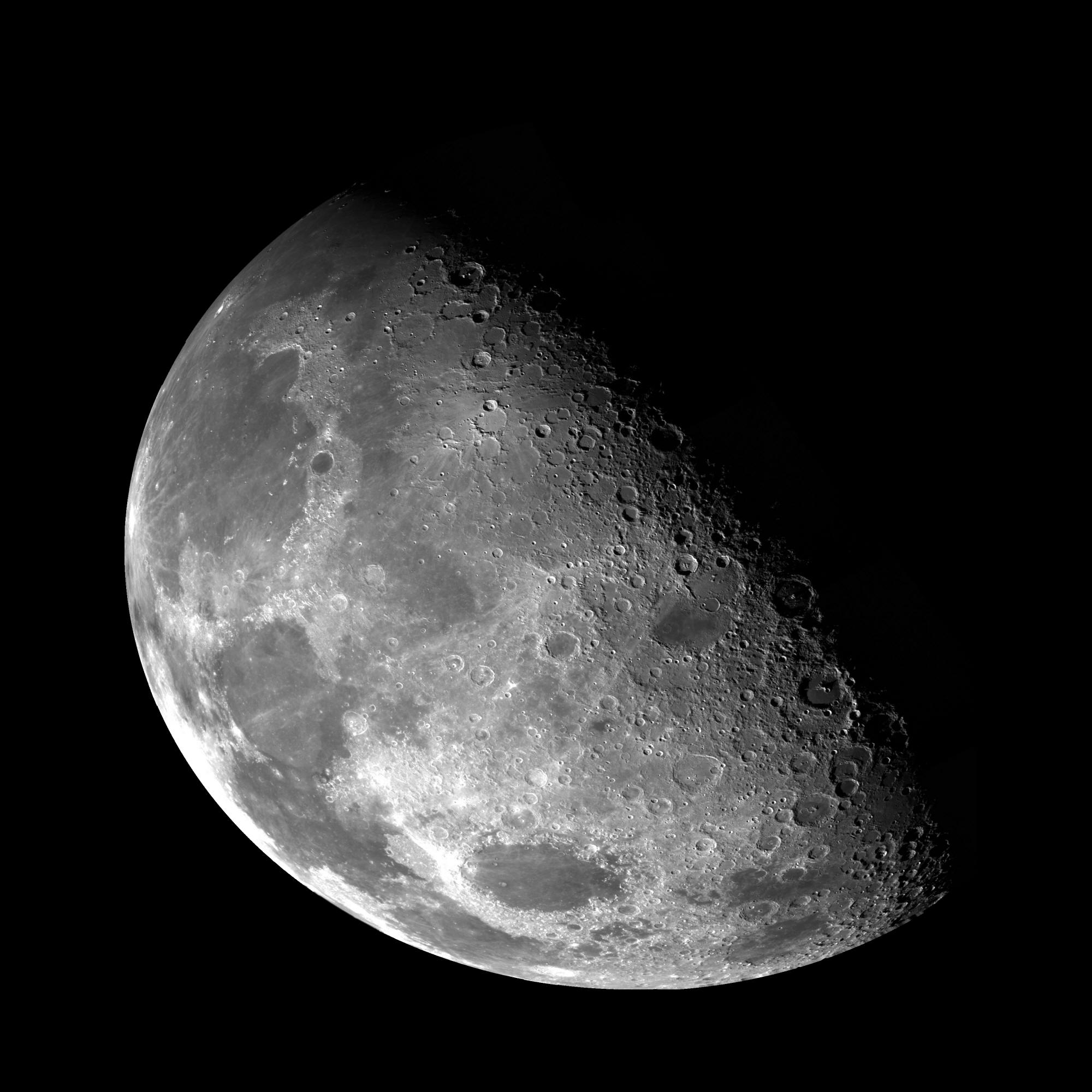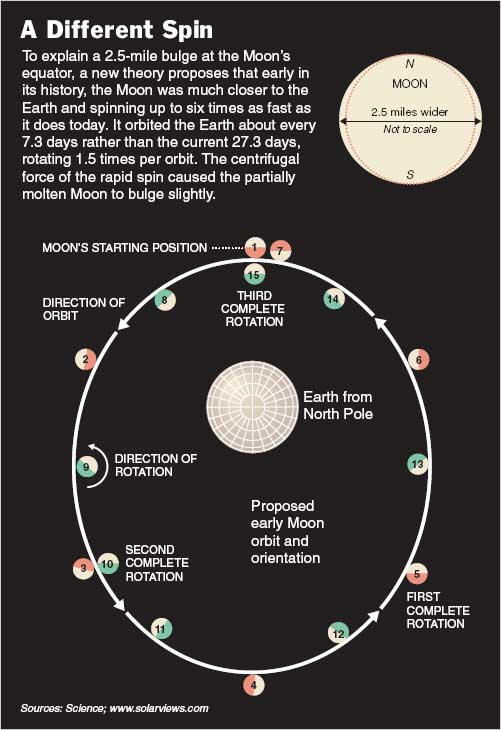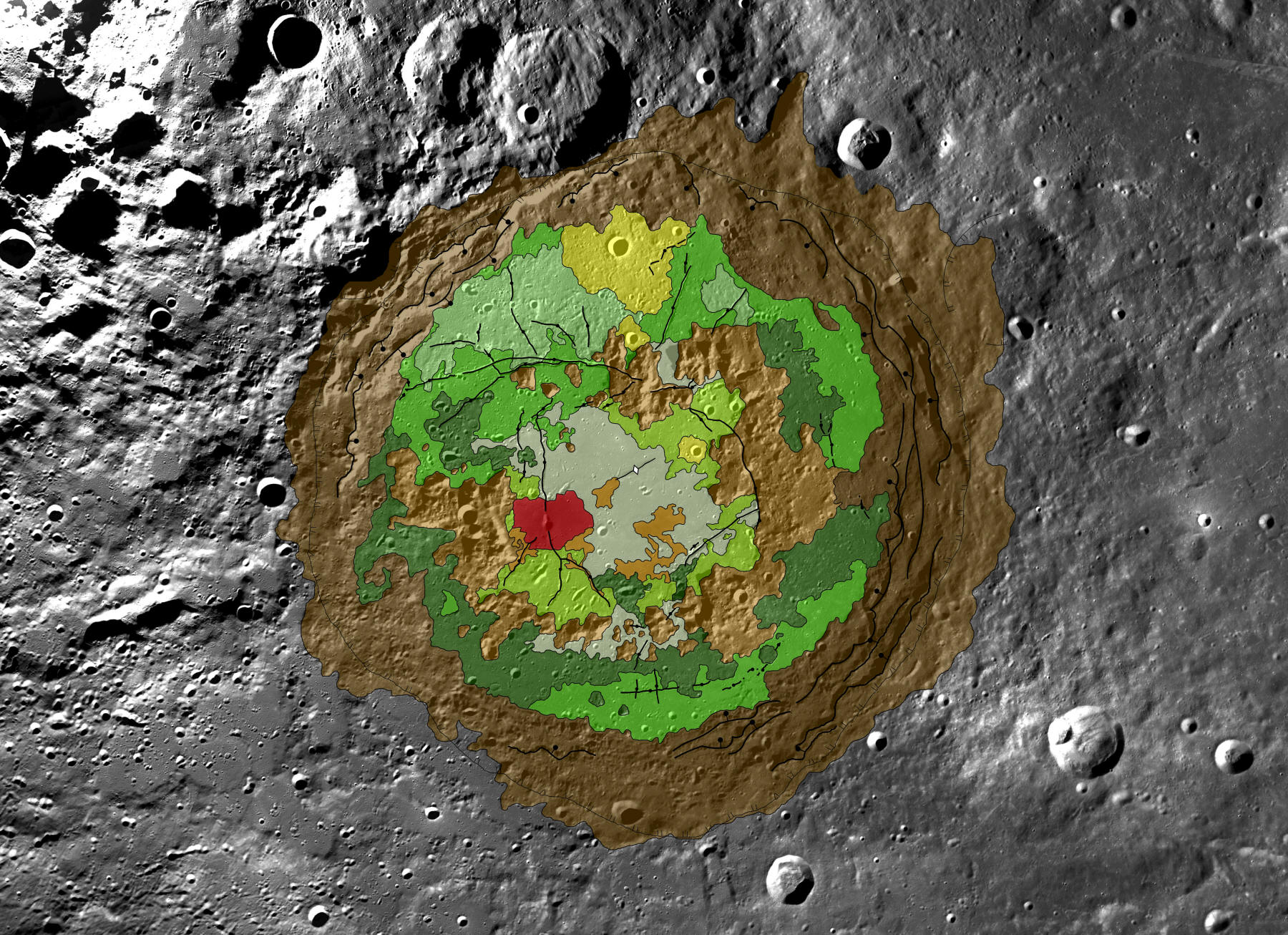|
Vocapedia >
Space > Solar system
Earth's satellite > Moon

Title
Galileo Images the Moon
Full Description
This view of the Moon's north pole
is a mosaic assembled from 18 images
taken
by Galileo's imaging system
through a green filter as the spacecraft flew by
on
December 7, 1992.
The left part of the Moon
is visible from Earth;
this region includes
the dark,
lava-filled Mare Imbrium
(upper left);
Mare Serenitatis
(middle left);
Mare Tranquillitatis
(lower left),
and Mare Crisium,
the dark circular feature
toward the bottom of the mosaic.
Also visible in this view
are the dark lava plains of the Marginis
and Smythii
Basins at the lower right.
The Humboldtianum Basin,
a 650-kilometer (400-mile) impact structure
partly
filled with dark volcanic deposits,
is seen at the center of the image.
The Moon's north pole
is located just inside the shadow zone,
about a third of
the way
from the top left of the illuminated region.
Nasa
http://en.wikipedia.org/wiki/Wikipedia:Featured_picture_candidates/December-2006
NASA Center: Jet Propulsion Laboratory
Image # : PIA00130
Date : 12/14/1992
Added 26 April 2007
http://en.wikipedia.org/wiki/Wikipedia:Featured_picture_candidates/December-2006

NYT
August 7, 2006
Scientists Chip Away at Mysteries of the Moon
NYT
8 August 2006
http://www.nytimes.com/2006/08/08/science/space/08moon.html

This detailed geologic map of Schrödinger
basin,
which formed when a huge object struck the
moon,
reveals a patchwork of lunar material,
including the peak ring (inner brown ring),
recent volcanic activity (red),
cratering (yellow)
and plains material (dark
green and kelly green).
Credit: NASA/Scott Mest
The Moon Puts on Camo
08.30.2010 -
A new geologic map of the
moon's Schrödinger basin
paints an instant, camouflage-colored portrait
of what a mash-up the moon's surface
is
after eons of violent events.
The geologic record at Schrödinger is still
relatively fresh
because the basin is only about 3.8 billion years old;
this makes it the moon's second-youngest
large basin
(it's roughly 320 kilometers, or 200 miles, in diameter).
NASA
http://www.nasa.gov/mission_pages/LRO/news/camo-moon.html - broken link
Related
https://www.theguardian.com/science/2010/sep/17/
map-moon-craters
moon
UK / USA
https://www.theguardian.com/science/
moon
https://en.wikipedia.org/wiki/
Moon
https://www.google.com/moon/
2024
https://www.npr.org/2024/04/09/
1243405460/space-news-moon-nasa-time-zone-white-house
https://www.npr.org/2024/02/22/
1232912368/moon-landing-intuitive-machines-odysseus-private-company-american
https://www.npr.org/2024/02/19/
1232287487/moon-landing-odysseus-private-company
https://www.theguardian.com/news/audio/2024/jan/19/
the-race-for-the-moon-podcast
2023
https://www.theguardian.com/science/2023/mar/27/
glass-beads-on-moon-surface-hold-billions-of-tonnes-of-water-
scientists-say
2022
https://www.npr.org/2022/09/03/
1120007415/goodnight-moon-has-comforted-kids-at-bedtime-for-75-years
https://www.theguardian.com/science/2022/aug/26/a
pollo-space-moon-missions-photographs-remastered-neil-armstrong
https://www.gocomics.com/stevebreen/2022/08/19
https://www.npr.org/2022/07/30/
1114709619/moon-research-habitation-stable-temperatures
https://www.nytimes.com/2022/06/26/
science/nasa-capstone-moon-launch.html
2021
https://www.gocomics.com/origins-of-the-sunday-comics/2021/09/26
https://www.nytimes.com/2021/03/04/
science/moon-tail-beam.html
https://www.npr.org/2020/10/26/
927869069/water-on-the-moon-
nasa-confirms-water-molecules-on-our-neighbors-sunny-surface
https://www.nytimes.com/interactive/2020/
science/exploring-the-solar-system.html - July 30, 2020
2019
https://www.npr.org/2022/03/03/
1084306173/in-a-first-
a-mysterious-rocket-part-is-about-to-slam-into-the-moon-by-accident
https://www.npr.org/2019/10/23/
772742561/the-dark-side-of-the-moon
https://www.npr.org/2019/07/22/
744023616/as-nasas-apollo-space-program-grew-alabama-was-pressured-to-desegregate
https://www.npr.org/2019/07/13/
735314929/the-camera-that-went-to-the-moon-and-changed-how-we-see-it
https://www.npr.org/2019/07/12/
736617703/as-america-celebrates-apollo-a-new-moon-race-is-underway
https://www.npr.org/2019/07/07/
734474121/as-nasa-aims-for-the-moon-
an-aging-space-station-faces-an-uncertain-future
https://www.nytimes.com/2019/05/13/
science/moon-moonquakes-tectonic.html
https://www.npr.org/2019/02/21/
696129505/how-do-you-preserve-history-on-the-moon
https://www.theguardian.com/science/audio/2019/jan/11/
exploring-the-far-side-of-the-moon-science-weekly-podcast
2017
https://www.npr.org/sections/alltechconsidered/2017/08/02/
540914751/from-family-snapshots-to-nasa-photos-
archivists-aim-to-solve-preservation-puzzle
2016
http://www.nytimes.com/2016/10/28/us/
ewen-whitaker-dies-nasa-moon-mapping.html
http://www.npr.org/sections/thetwo-way/2016/10/15/
498081878/look-up-the-moon-is-going-to-be-amazing-this-weekend
2015
http://www.theguardian.com/science/2015/aug/06/
dark-side-of-the-moon-captured-by-nasa-satellite-16m-kilometres-from-earth
2014
http://www.nytimes.com/2014/09/09/
science/revisiting-the-moon.html
http://www.nytimes.com/2014/07/31/science/space/the-moon-
is-slightly-flat-scientists-say.html
http://www.theguardian.com/science/2014/jun/05/moon-
impact-collision-apollo-mission-rocks-mars
http://www.theguardian.com/science/2014/feb/24/meteorite-moon-
largest-lunar-impact-recorded
http://www.guardian.co.uk/science/2010/sep/17/
map-moon-craters
http://www.guardian.co.uk/science/1969/jul/21/
spaceexploration.archive1
beaver moon
UK
The Beaver Moon is the last full moon
before the winter solstice
https://www.theguardian.com/uk-news/gallery/2023/nov/28/
rohingya-refugees-and-a-stranded-plane-photos-of-the-day-tuesday
dark side of the moon
UK
http://www.theguardian.com/science/2015/aug/06/
dark-side-of-the-moon-captured-by-nasa-satellite-16m-kilometres-from-earth
https://en.wikipedia.org/wiki/
The_Dark_Side_of_the_Moon
moonscapes USA
http://www.nytimes.com/2015/02/24/
science/space-photos.html
earthrise USA
http://www.nytimes.com/2015/02/24/
science/space-photos.html
blood moon USA
http://www.npr.org/sections/thetwo-way/2015/09/25/
443402306/sundays-lunar-eclipse-has-got-it-all
super blood moon USA
http://www.nytimes.com/2015/09/26/
science/super-blood-moon-to-make-last-appearance-until-2033.html
super blue blood moon UK
https://www.theguardian.com/science/video/2018/jan/30/
what-is-the-super-blue-blood-moon-video
super blue blood moon USA
https://www.npr.org/sections/thetwo-way/2018/01/30/
581890038/wednesdays-rare-super-blue-blood-moon-
how-to-see-it-and-what-we-can-learn
moon's crust UK
http://www.guardian.co.uk/science/2012/dec/18/
nasa-crashes-twin-probes-into-moon
moonrise
full moon UK
https://www.theguardian.com/science/shortcuts/2012/nov/21/
the-full-moon-pass-notes
https://www.theguardian.com/science/2008/dec/13/
astronomy-space-full-moon
full moon USA
http://www.npr.org/sections/thetwo-way/2017/02/11/
514688792/photos-green-comet-snow-moon-and-eclipse-make-for-a-space-trifecta
harvest moon USA
unlike the equinoxes,
which take place at the same time each year,
the harvest moon is the full moon
closest to the autumnal equinox.
Which means
it can fall in September or October,
according to The Old Farmer's Almanac.
https://www.npr.org/2021/09/18/
1038602877/celebrate-the-end-of-summer-with-mondays-harvest-moon
https://en.wikipedia.org/wiki/Harvest_Moon_(album) - 1992
snow moon USA
http://www.npr.org/sections/thetwo-way/2017/02/11/
514688792/photos-green-comet-snow-moon-and-eclipse-make-for-a-space-trifecta
"supermoon"
UK / USA
A perigee moon is visible
when the moon's orbit position
is at
its closest point to Earth
during a full moon phase,
making the so-called super moon
look larger than
normal.
The closest and therefore
the biggest and brightest
full moon of the year.
https://www.npr.org/2022/07/12/
1111038172/buck-supermoon-july-full-moon
https://www.theguardian.com/science/gallery/2021/apr/27/
aprils-pink-supermoon-across-the-world-in-pictures
https://www.theguardian.com/science/gallery/2016/nov/14/
supermoon-in-pictures
http://www.npr.org/sections/thetwo-way/2016/11/13/
501854717/closest-supermoon-since-1948-arrives-monday-tips-on-seeing-and-photographing-it
https://www.theguardian.com/science/video/2016/nov/10/
what-is-the-supermoon-the-science-behind-the-lunar-wonder-video-explainer
http://www.npr.org/sections/thetwo-way/2016/10/15/
498081878/look-up-the-moon-is-going-to-be-amazing-this-weekend
http://www.npr.org/sections/thetwo-way/2015/09/25/
443402306/sundays-lunar-eclipse-has-got-it-all
http://www.theguardian.com/science/gallery/2015/aug/30/
first-supermoon-2015-in-pictures
http://www.theguardian.com/science/2014/sep/09/
-sp-10-things-you-should-know-about-the-supermoon
http://www.boston.com/bigpicture/2014/08/
supermoon_photographs_from_around_the_world.html
http://www.theguardian.com/science/gallery/2014/aug/10/
supermoon-skies-perigee-around-the-world-in-pictures
http://www.theguardian.com/science/video/2014/jul/13/
supermoon-world-video
http://www.boston.com/bigpicture/2013/06/supermoon_2013.html
https://www.theguardian.com/science/gallery/2013/jun/23/
supermoon-elliptical-orbit-world-in-pictures
http://www.guardian.co.uk/science/gallery/2012/may/06/supermoon-rises-in-pictures
http://www.guardian.co.uk/science/2012/may/05/supermoon-lunar-close-pass
http://www.guardian.co.uk/science/gallery/2011/mar/20/super-moon-in-pictures
strawberry supermoon
USA
https://www.npr.org/2022/06/13/
1104547804/strawberry-supermoon-tuesday-june-full-moon
super flower blood moon
USA
https://www.npr.org/2022/05/16/
1099064064/super-flower-blood-moon-reaction
buck supermoon USA
https://www.npr.org/2022/07/12/
1111038172/buck-supermoon-july-full-moon
perigee UK / USA
https://www.npr.org/2022/07/12/
1111038172/buck-supermoon-july-full-moon
https://www.theguardian.com/science/2008/dec/13/
astronomy-space-full-moon
total lunar eclipse USA
https://www.npr.org/2022/11/07/
1134688501/lunar-eclipse-this-week-november-2022
Boston Globe > Big Picture
Lunar eclipse of December 10, 2011
USA
December 12, 2011
The longest lunar eclipse
in over ten years
animated the night
sky
on December 10.
The red hue
resulted from the sun's light
passing through the earth's
atmosphere.
Viewers in Asia
had the best view of the total eclipse,
while those watching in Europe
saw part of it at moonrise,
and North Americans
caught part of it as the moon set.
It was not visible
in South America or Antarctica.
The next total eclipse
will occur in 2014.
http://www.boston.com/bigpicture/2011/12/
lunar_eclipse_of_december_10_2.html
Lunar eclipse
viewed from around the world - in pictures
UK
June 2011
Skywatchers
from Brussels to Beirut
turn their gaze to the moon
as it turns red
during the eclipse
http://www.guardian.co.uk/science/gallery/2011/jun/16/
lunar-eclipse-moon-gallery-pictures
total lunar eclipse
February 2008
During the eclipse,
the Earth lined up directly
between the Sun and the Moon,
casting Earth's shadow
over the Moon.
http://www.reuters.com/news/pictures/slideshow?
collectionId=1597&galleryName=All%20Collections#a=1 - broken link
https://www.reuters.com/article/scienceNews/idUSL20284994
20080221
lunar eclipse UK / USA
- the earth prevents the sun’s rays
from reaching
the moon
https://www.nasa.gov/eclipse
https://www.nasa.gov/topics/
solarsystem/features/eclipse/dec20-21_eclipse.html
https://eclipse.gsfc.nasa.gov/OH/OH2010.html#LE2010Dec21T
http://hyperphysics.phy-astr.gsu.edu/hbase/Solar/lunecl.html
https://www.npr.org/2022/11/07/
1134688501/lunar-eclipse-this-week-november-2022
https://www.theguardian.com/science/gallery/2010/dec/21/
moon-solar-eclipse
http://cityroom.blogs.nytimes.com/2010/12/20/are-you-watching-tonights-eclipse/
partial lunar eclipse
total lunar eclipse / syzygy
UK
a total lunar eclipse
due to a perfect alignment
of the sun, Earth and the moon,
otherwise known as a syzygy
http://www.theguardian.com/science/gallery/2014/apr/15/
blood-moon-lunar-eclipse-in-pictures
water on the moon UK /
USA
http://www.npr.org/sections/thetwo-way/2017/07/24/
539066277/a-new-study-shows-the-moons-interior-could-contain-water
http://www.nytimes.com/2009/11/27/opinion/l27moon.html
http://www.nytimes.com/2009/11/20/opinion/20marshall.html
https://www.theguardian.com/science/2008/jul/10/
spaceexploration.usa
pop music > lunar tunes
UK
https://www.theguardian.com/music/musicblog/2009/jul/20/
moon-eclipses-sun-pop
lunar art
- iconic works inspired by the moon
UK
https://www.theguardian.com/artanddesign/2009/jul/21/
moon-art-exhibitions-history
Corpus of news articles
Space > Earth > Moon
Total lunar eclipse turns Moon red
Thu Feb 21, 2008
7:23am EST
Reuters
LONDON (Reuters) - Thousands of hopeful astronomers around the world tried to
catch a glimpse of the year's only total lunar eclipse -- but those watching
from Britain saw little more than cloud.
Watchers from the eastern United States saw it easily Wednesday night and had
posted dozens of successful pictures on the Internet -- but by mid-morning none
had been posted from Britain, where it should have been most visible between 3
a.m. and 4 a.m. British time Thursday (10 p.m. and 11 p.m. EST Wednesday).
"It's been pretty grim," said John Mason, spokesman for the British Astronomical
Association. "There were a couple of gaps in the cloud for a couple of seconds
from where I was but nothing else."
During the eclipse, the Earth lined up directly between the Sun and Moon,
covering the latter with the Earth's shadow. Depending on atmospheric conditions
on Earth, the moon should have appeared blood red, rusty or grey.
The Royal Astronomical Society had promised a "spectacular sight", saying that
unlike a solar eclipse it could be viewed without any special equipment.
But in the event, special equipment would have been unnecessary anyway. The next
lunar eclipse will not be seen until December 2010.
"It's bad luck," said Royal Astronomical Society spokesman Robert Massey. "But
it's always one of these things when you're watching from the UK."
(Reporting by Peter Apps)
Total lunar eclipse
turns Moon red, R, 21.2.2008,
https://www.reuters.com/article/scienceNews/idUSL20284994
20080221/
Total Lunar Eclipse
Early Tuesday
August 26, 2007
Filed at 7:48 p.m. ET
The New York Times
By THE ASSOCIATED PRESS
DENVER (AP) -- The Earth's shadow will creep across the moon's surface early
Tuesday, slowly eclipsing it and turning it to shades of orange and red.
The total lunar eclipse, the second this year, will be visible in North and
South America, especially in the West. People in the Pacific islands, eastern
Asia, Australia and New Zealand also will be able to view it if skies are clear.
People in Europe, Africa or the Middle East, who had the best view of the last
total lunar eclipse in March, won't see this one because the moon will have set
when the partial eclipse begins at 4:51 a.m. EDT. The full eclipse will begin an
hour later at 5:52 a.m. EDT.
An eclipse occurs when Earth passes between the sun and the moon, blocking the
sun's light. It's rare because the moon is usually either above or below the
plane of Earth's orbit.
Since the Earth is bigger than the moon, the process of the Earth's shadow
taking a bigger and bigger ''bite'' out of the moon, totally eclipsing it before
the shadow recedes, lasts about 3 1/2 hours, said Doug Duncan, director of the
University of Colorado's Fiske Planetarium. The total eclipse phase, in which
the moon has an orange or reddish glow, lasts about 1 1/2 hours.
The full eclipse will be visible across the United States, but East Coast
viewers will only have about a half-hour to see it before the sun begins to rise
and the moon sets. Skywatchers in the West will get the full show.
In eastern Asia, the moon will rise in various stages of eclipse.
During the full eclipse, the moon won't be completely dark because some light
still reaches it around the edges of the Earth. The light is refracted as it
passes through our atmosphere, scattering blue light -- which is why the sky is
blue -- but sending reddish light onto the moon.
''When someone asks why is it (the moon) red, you can say because the sky is
blue,'' Duncan said.
The next total lunar eclipse occurs Feb. 21, 2008, and will be visible from the
Americas, Europe and Asia.
Total Lunar Eclipse Early Tuesday,
NYT,
26.8.2007,
http://www.nytimes.com/aponline/us/
AP-Lunar-Eclipse.html
- broken link
Explore more on these topics
Anglonautes > Vocapedia
Moon > Apollo 11
First lunar landing
20 July 1969
Moon > Apollo 10
Testing the Lunar Module in lunar orbit
10-18 May 1969
Moon > Apollo 8
First human journey to another world
21-27 December 1968
astronauts
space, astronomy
Related > Anglonautes >
History
> 20th century > USA
Man on the moon - 20 July 1969
1962-1975
Cold War > Vietnam
War > USA
late 1940s - late 1980s
Cold war
after WW2 > Germany, USA >
Operation Paperclip
|